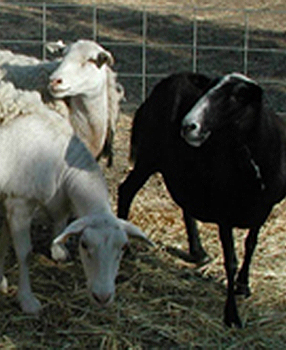
Baa baa blood test?
Rare sheep could be key to better diagnostic labs in developing world
By Stephanie Pappas
Photograph by Ellen Jo Baron
The newest revolution in microbiology testing walks on four legs and says “baa.”
It’s the hair sheep, a non-woolly version of the familiar barnyard resident. A recent study from the School of Medicine finds that not only are these ruminants low-maintenance and parasite-resistant, they’re also perfect blood donors for the microbiology tests necessary to diagnose infectious disease in the developing world.
Identifying microbes from a patient’s urine or sputum requires growing those microbes in culture dishes filled with gelatinous agar and a small amount of blood. The blood nourishes the microbes and provides clues to their identities: Microbiologists can rule out or identify certain strains of bacteria based on how the organisms interact with the blood cells in the culture.
In the developed world, microbiologists use sheep or horse blood. But in many parts of the developing world, horses are prohibitively expensive, and regular sheep, with their need for frequent shearing and tendency to get infections, are difficult to keep alive. Importing animal blood isn’t feasible either, as shipping is costly and often unreliable.
Many labs in the developing world use human blood, often donated by lab technicians themselves. But the use of human donors increases technicians’ risk of infection with blood-borne diseases. Besides, diagnostic tests aren’t standardized for human blood, says Ellen Yeh, MD, a resident in pathology at Stanford and primary author of an article on the study, published July 3 in the journal PLoS ONE. “You don’t get the same test results when you use human blood versus sheep blood,” she says.
Ellen Jo Baron, PhD, professor of pathology at the medical school, wanted to do better. She’s a veteran of overseas microbiology, having trained lab technicians from Botswana to Cambodia for more than a decade.
“Up until the time I saw a hair sheep — which I first saw in Botswana — I had no idea there was even such a thing,” says Baron, who is associate director of Stanford’s clinical microbiology lab, and was the paper’s senior author. She wasted no time in learning about the animals, finding that they resist parasites, don’t need to be sheared and do well in the tropical climes prevalent in much of the developing world.
But no one had tested whether their blood was equivalent to horse or sheep blood. So, calling in a favor from a colleague with a hobby farm near Walnut Creek, Calif., Baron and her colleagues collected blood from hair sheep — the animals are remarkably mellow about the donations, she says — and created test cultures using the blood. Then, with Baron funding the study, they ran a series of common diagnostic tests.
“It worked for every single thing,” Baron says.
Now, say Baron and Yeh, the only hurdle is getting the sheep to the labs that need them. Two veterinary labs in Botswana already provide hair sheep blood to local labs based on Baron’s initial results. Baron hopes to work with the charity Heifer International to promote donations of hair sheep to the developing world. After all, she says, the sheep can provide milk and meat — and that’s on top of their role in making diagnostic tests possible.


